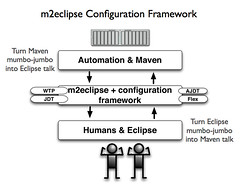This afternoon, I delivered my Building Rich Applications with Appcelerator talk for the 3rd time at Colorado Software Summit. When I first proposed this topic, I hadn't used Appcelerator and saw this as a good opportunity to learn more about it. I'm glad I did.
IMO, Appcelerator is a lot like Dojo in how it parses pages and turns HTML with special attributes into JavaScript widgets. I can't help but think a pre-compilation step would be nice to speed things up. I like Appcelerator's extensive Widget Library, and I especially like that they re-use many widgets rather than re-creating their own. Finally, I really dig the "SOA in a browser" approach where everything is a message and you can easily publish and subscribe to events - on the client and server. Below is my presentation, please let me know if you have any questions.
If you're going to choose Flex or OpenLaszlo, chances are you're targeting Flash. The Flash Player allows you to abstract the browser idiosyncrasies and give users a better experience. It hides the browser quirks from both developers and users. It's also a highly ubiquitous web browser runtime environment. It provides a user experience way beyond traditional HTTP request-response. Also, its visual effects and "richness" rival of non-browser desktop applications.
Mark's blog stats show that 95% of readers are using Flash 9 and 1% is Flash 10. All others don't have their version exposed. Most other sources claim that Flash 9 has 98% penetration in mature markets. One of the nicest things about Flash is it frees users from limitations of traditional web applications. Request/response is largely a thing of the past and Ajax-like behavior was built-in from the beginning.
Flash Criticisms: has reduced SEO as well as bookmarking and URL history support.
Flash Player Criticisms: not open source, no significant alternative, no 64-bit player, loading performance and it's only useful for games, movies and annoying advertisements.
The good news is Flash is getting better. There's currently a SWF Searchability initiative with Google and Yahoo!. For bookmarking and URL History, you can use "deep linking" with mx.managers.BrowserManager and mx.managers.HistoryManager. Flash Player issues are also being addressed. There's a Flash Open Screen Project, there's a 64-bit player in Adobe Labs and Flash 9/10 is much better than in the past.
To prove that Flash is a compelling technology, all you have to do is look at Microsoft's Silverlight and Sun's JavaFX. These are direct competitors that are fairly new and prove that companies like what Flash has.
Flex
Flex is not Flash. Flex requires Flash (9+), but Flash does not require Flex. Flex is a language and framework and applications are compiled into .swf files. Flash is the runtime environment that executes .swf files. Flex 3 is FREE. The Flex SDK, compiler and debugger are open source. They have no license costs. BlazeDS is also open source and has no license cost.
Flex MXML was formerly called Macromedia XML. It's an XML-based presentation/layout language that's editable with any text editor or IDE. MXML is to ActionScript 3 as JSP is to Java. MXML provides the layout and ActionScript provides the dynamic business logic.
ActionScript
ActionScript is an ECMAScript implementation that's been proposed as the Edition 4 implementation. It's not your older sibling's JavaScript. It uses class-based object-oriented features and static typing. Thanks to the Flash Player, it works the same across multiple browsers. Most of the things you can do with MXML, you can do with ActionScript. However, MXML typically requires less LOC.
ActionScript allows packages, interfaces, inheritance, objects and methods. It includes extensive XML Support, particularly E4X (ECMAScript for XML). It has a large class library and can talk directly to the Flash Player. Finally, it has many Java-like features and it's syntax looks similar.
At this point, Dustin started doing demos of two popular Flex components: RichText Editor (which creates horrible HTML) and Data Grid. More third-party Flex components seem to appear every day. Examples include flexlib, ASDIA as well as all those listed on FlexBox. Additionally, it's not too difficult to create your own Flex components (no proof provided).
Flex's property binding is one of Dustin's favorite features, but he says he has a difficult time conveying how cool it is. Property binding allows you to tie data in one object to data in another object. Updates in one object affect another. To use it in MXML, you can use curly braces or the BindingUtils object. You can also use Flex's metadata annotation "Bindable" to denote bindable objects.
To compile Flex applications, you can use mxmlc from the command line. You can use Ant with the <exec> task or using Flex's Ant Tasks. You can also invoke mxmlc from Java as long as you include mxmlc.jar in your classpath. FlexBuilder is an Eclipse-based IDE that's not included with the free Flex SDK. It's not a free product and can be used as a plugin or a standalone IDE.
Flex and Java
There's two predominant out-of-the-box methods for Flex to communicate with Java EE backends.
- HttpService: traditional HTTP request/response.
- WebService: SOAP-based Web Services.
If the above two methods aren't fast enough, you can use BlaseDS and it's additional options.
- Web Messaging: HTTP publish/subscribe with JMS, ColdFusion and/or other Flash/Ajax client.
- Remoting with AMF: access server-side objects from Flash client-tier as if they were hosted there.
Flash applications can access either a client's machine or a remote site, but not both. You can use a crossdomain.xml file on your server to allow remote Flash clients to connect. This file allows access for both Flex and OpenLaszlo applications.
BlazeDS adds proxy server support for HTTPService and WebService. To use, set the useProxy attribute to "true". Features include authentication and logging. It adds a new RPC mechanisms called RemoteObject. This object allows ActionScript and Java EE transparent integration. It also adds publish/subscribe messaging with a JMS Adapter available. Lastly, it adds Ajax support to your Flex application.
GraniteDS is an open-source (LGPL) alternative to Adobe LiveCycle and is similar to BlazeDS. It has COMET-like functionality and supports Spring, Spring Security, EJB 3, Seam and Guice.
Flex Frameworks: Cairngorm (Adobe Consulting), Pure MVC, Mate and many others.
Flex 4 (Gumbo) will have improvements for designers (easier customization, better tool support), improvements for developers (faster compiler, two-way data binding) and will leverage new features of Flash 10.
OpenLazlo
OpenLaszlo 4 is XML-based and uses an XPath syntax for data access. OpenLaszlo was actually created before Flex and is ECMAScript-based. Unlike Flex that requires Flash 9, OpenLaszlo is architected to deploy on different runtime environments, including: Flash 7/8/9 and DHTML. Dustin believes OpenLaszlo would be a lot more appealing if your source code could be compiled into Silverlight or JavaFX.
OpenLaszlo's syntax looks a lot like Flex, except it does not use namespaces. OpenLaszlo's Constraints are similar to Flex's property binding, except the syntax is a bit different. You use ${} in LZX tags or applyConstraint() and LzDelegate in scripts. OpenLaszlo's event handling is similar to Flex and JavaScript event handling. All attributes have an implicit "on" event that is triggered when an attribute's value is changed. Event handlers can be written CSS-style in LZX nodes or using the <handler></handler> tag. Script code can be embedded in LZX XML in many ways:
- Inside event attributes
- Within
<script></script> tags
- Within
<method></method> tags
- Within
<handler></handler> tags
- In a separate file (
<script src="someFile.js" />)
Dustin believes the debugger and view-source tools in OpenLaszlo are much better than the ones available for Flex.
For the rest of the presentation, Dustin covered many of Laszlo's feature, how they relate to Java as well as how to integrate SWF and HTML. SWFObject is Dustin's preferred method for adding Flash to HTML. One of its nifty features is it allows SWF-to-SWF communication.
This talk was an excellent and in-depth overview of Flash, Flex and OpenLaszlo. I especially liked all the details on ActionScript and the different methods for remote communication. Nice job Dustin!
 This week I'm doing a research project for a client. The main purpose of the project is to find out which Java-based web framework works best with Dojo and Comet. Here's the key requirement from the client:
This week I'm doing a research project for a client. The main purpose of the project is to find out which Java-based web framework works best with Dojo and Comet. Here's the key requirement from the client:









